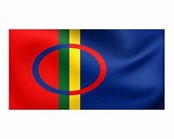
The association for Sami Traditional folk musicians

Juoigiid Searvi, founded on 14 November 1998, is the association for Sami Traditional folk musicians.
Its main aims are
–To preserve, strengthen and develop juoigan, the traditional Sami form of singing.
–To promote, advise and teach about juoigan.
Website: www.samidaiddar.no
E-mail: post@samidaiddar.no
Address: SDR, Boks 23, 9730 Kárášjohka
Phone: +47 78 46 70 06
A brief introduction to luohti
Luohti, leudd, vuolie and juoiggus are words to describe traditional Sami music. If there is a text it is called dajahusat.
In music terms, many North Sami luohti are in a pentatonic scale, using intervals such as major seconds, major thirds and hole octaves.
There are three main types of luohti, nature luohti, place luohti and animal luohti.
It is important to understand the subject of the luohti, person or thing, is being sung, not just sung about. For example, a luohti portrays the person being sung.
An energetic person will have a luohti that is both rhythmically and melodically energetic; a reserved person will have a calmer luohti.
Luohti focuses on the special characteristics of the person, animal, river, mountain, lake or moorland. The melody is the most important element.
However, luohti is more than a melody and a musical form. It is also a form for communication, an element in child upbringing, a confirmation and strengthening of the identity of person being sung.
In Sami society individual identity is not primarily stressed. It is more important for a person to experience a confirmation of belonging to the family and the community. Therefore, luohti has a role of child rearing. A child will receive its own luohti, called dovdna.
Dovdna is used to motivate the child, strengthen its identity and increase self-esteem. The dovdna may be used to persuade the child to do something it doesn`t want to. Even when the child realizes why the dovdna is being sung, it is hard for it to refuse since it has already been praised for doing it.
A luohti describes a special characteristic of the person or thing being sung. The special feature is characterized in the melody and in a short, telling text.
Luohti can be candid, exposing and double-bottomed. Often the text consists of hints, innuendo and metaphor, so that only those who know the person will fully understand. In this way luohti can be used as a means of communication.
Emotion is always present during a luohti, both of the singer and the emotions the singer has to person being sung. The singer reveals this feeling in the manner he presents the luohti, both in through his expression of the text, the melody, the rhythm, the tone and the intensity. There is a unity between the melody and the content of the luohti.
Thus there is something deeply personal involved inside the singer of a luohti.
Luohti is like or can be as a good friend. If you are on your own and sing a luohti you get the experience of having a friend, there with you. Further, through luohti the singer can recall people and places, with love, longin, happiness or sorrow. Luohti, it is said, has no beginning nor ending.

 English
English  Norsk
Norsk  Suomi
Suomi  Pусский
Pусский  Åarjelsaemiengïelese
Åarjelsaemiengïelese 